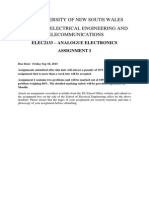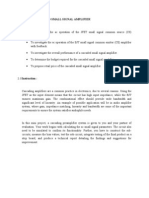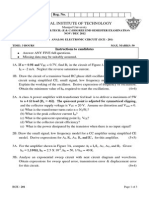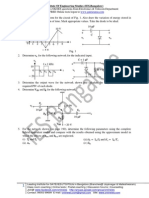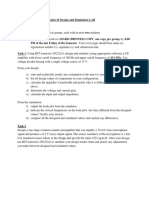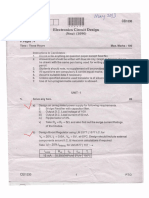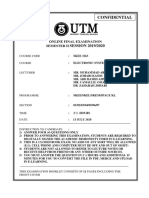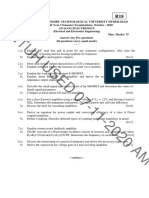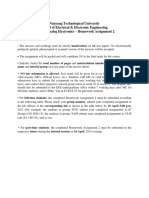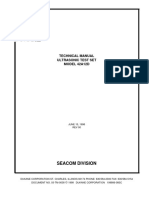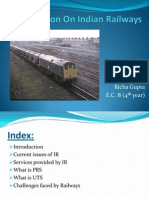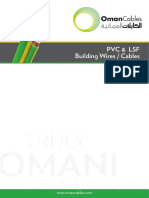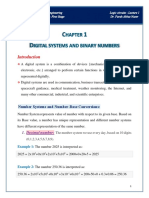Nanyang Technological University
School of Electrical & Electronic Engineering
EE2002 Analog Electronics – Homework Assignment 1
Instructions:
• This assignment contains one question, from parts (a) to (l) and one figure.
• The answers and workings must be strictly handwritten on A4 size papers. No electronically produced,
printed, photocopied or scanned version of the answers will be accepted.
• Indicate clearly the total number of pages and matriculation number on the first page, and name and
tutorial group on every page of the answer sheets.
• For full-time students, the completed Homework Assignment 1 must be submitted according to the
following table. Please check your group number, submit your completed assignment to the lab officers at
the corresponding lab as shown in the table below by 20 March 5:00 p.m, 2013 (For example, the
students in groups TC01 submit your completed assignments to IC Design I (S1-B2b-13); the students in
groups TA09 submit your completed assignments to VLSI Lab (S2.1-B3-01), and so on so forth).
Labs Lab Officers Students groups Tutorial Professors
IC Design I (S1-B2b-13) Quek-Gan Siew Kim TC01, TC02, TC08,TA04,TA05 Asst Prof
<ESKQUEK@ntu.edu.sg>; Hau Wai Kim Tae Hyoung
Ping <EWPHAU@ntu.edu.sg> Boon Chirn Chye
IC Design II (S1-B2b-10) Seow-Guee Geok Lian TC07,TC09,TA01,TA07,TA08,TA11,TA12 Assoc Prof
<EGLGUEE@ntu.edu.sg>; Goh Mia Chang Chip Hong
Yong Jimmy <EMYGoh@ntu.edu.sg>
Integrated System Leong-Tung Wang Why TC05,TC06,TC10,TC11,TA02,TA03,TA06 Asst Prof
Research (S1-B2a-04) <EWWLEONG@ntu.edu.sg>; Kang Zheng Yuanjin
Meng Fai <EMFKang@ntu.edu.sg>
VLSI Lab (S2.1-B3-01) Sia Liang Poo TC03,TC04,TA09,TA010 Assoc Prof
<ELPSIA@ntu.edu.sg>; Seow Yong Tan Cher Ming
Hing <EYHSEOW@ntu.edu.sg>
• For part-time students, the completed Homework Assignment 1 must be submitted to the respective tutors
during the tutorial session on 20 March, 2013 evening.
• NO late submission is allowed. Zero mark will be given for no or late submission without valid reasons
(MCs, Official Leave, etc.).
Question:
For the BJT amplifier circuit given in Figure 1, it has VEE = VCC = 15 V, RI = 550 , R1 = R2 = 200 k,
RL = 100 k, RC = 10 k RE1 = 50 kand RE2 = 150 k. Assume the transistor is with VBE = 0.7 V,
VA = 60V, and = 100, and the capacitors have infinite value. In your answers to the following parts,
please express all fractional voltage and current values in mV and mA respectively up to two decimal places
in your calculation. Resistance values that are larger than 1000 should be expressed in k.
1
�(a) Draw the DC equivalent circuit.
(b) Calculate the Q-point of the transistor Q in Figure 1.
(c) Determine if the transistor Q is operating in the forward active region.
(d) Calculate the DC power dissipation of each component of the circuit.
(e) Verify that the total DC power dissipated by the circuit computed in (d) is equal to the total power
delivered by VEE and VSS.
(f) Draw small signal equivalent circuit of the amplifier.
(g) Calculate the resistances , of the amplifier.
(h) If vi = 0.2sinωt mA, what will be the output voltage vo?
(i) Calculate the current gain .
(j) What is the maximum amplitude of the input signal vi for this small signal analysis to be valid? Will the
output waveform of (h) be distorted?
(k) What will be the value of RI to maximize the voltage gain of this amplifier?
(l) Without changing the transistor, suggest two effective ways to increase the voltage gain of this amplifier
circuit. Please indicate the direction of change (increase or decrease) if your suggestions involve changes in
component values.
+VCC
RC C3
R2
RI C1
Q
C2
+
vi - +
Rin RE1
R1 RL
Rout vo
-
C4
RE2
VEE
Figure 1

